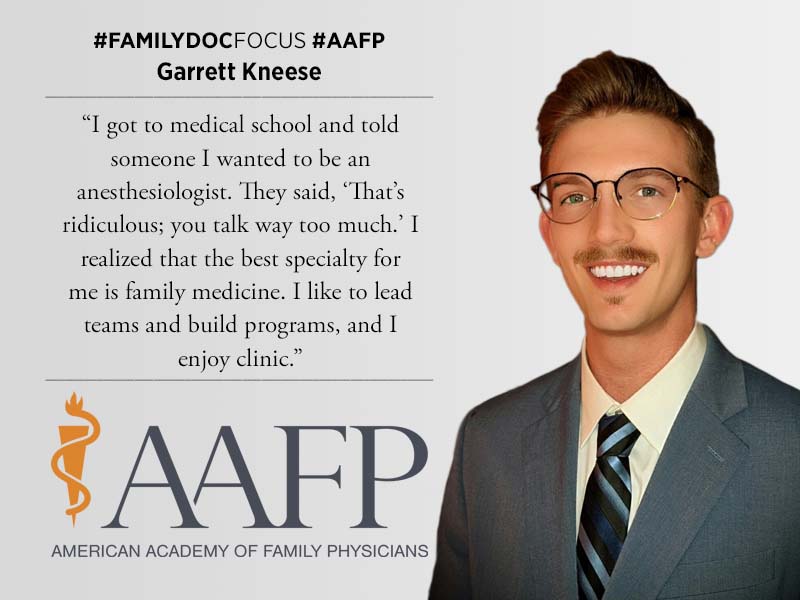No Shortcuts for Med Student Leader
January 25, 2021, 2:00 pm David Mitchell — When Garrett Kneese entered a combined bachelor of science and doctor of medicine program at the University of Texas at San Antonio, his goal was to graduate in seven years instead of the typical eight. Instead, he’ll finish next year — his ninth — after a couple of well-intended detours.

“The program was designed to speed up the pipeline of primary care physicians in Texas, particularly in underserved areas,” said Kneese, a Houston native. “I clearly disrupted some expectations when I decided to serve in Ecuador and South Texas, but I’ll be a better doctor in the end. And I’m committed to staying in Texas.”
Kneese is a first-generation college graduate who was inspired to become a physician by his mother’s struggles with multiple autoimmune disorders. During his teenage years, his mother used a wheelchair for months until doctors were able to formulate a treatment plan for her severe rheumatoid arthritis and other factors.
“Her physicians gave her back to me,” Kneese said. “I realized I could give that gift back to someone else, and that was my entry point to medicine.”
Kneese said he initially considered a career in anesthesiology due his interests in chemistry and biology, but he soon realized his personality was better suited to family medicine because of its emphasis on building relationships with patients.
“I got to medical school and told someone I wanted to be an anesthesiologist,” Kneese said. “They said, ‘That’s ridiculous; you talk way too much.’ I realized that the best specialty for me is family medicine. I like to lead teams and build programs, and I enjoy clinic.”
Determined to practice in Texas, Kneese made his first trip to Ecuador for a medical Spanish course with the Cacha Medical Spanish Institute.
“In Texas, if you don’t speak Spanish, you’re going to be limited in the scope of people you can help,” he said.
In Ecuador, Kneese met Margarita Guevara, M.D., who had served previously with the country’s ministry of public health and was the governor of the province of Chimborazo. After Kneese completed his second year of medical school, Guevara recruited him back to Ecuador to help develop a comprehensive sexual education program in public schools.
Kneese said Ecuador has a high adolescent pregnancy rate relative to its investment in health and education. The country already had two of the three elements in place needed to address the problem — health care rights and access to services.
“The only missing piece was education,” he said.
“We did a good job of making our case to the ministries of education and public health,” said Kneese, who spent a year as program director, working with both ministries and the non-profit Cacha Medical Spanish Institute, utilizing a Spanish-language curriculum developed for South Texas communities by family physician Janet Realini, M.D., M.P.H., a champion for adolescent sexual health in the state. “The outcome we’re looking for isn’t just reduced teen fertility.”
The bigger picture, he said, includes keeping students in school and promoting higher education, which would benefit the workforce and stabilize the country.
Kneese returned to the United States to continue his medical training, but Jason Rosenfeld, Dr.P.H., M.P.H., the assistant director of global health at UT Health San Antonio, had another suggestion. Rosenfeld was looking for someone who spoke fluent Spanish, had experience managing and implementing programs, and understood Latino culture.
“It was another door that opened, and I felt like I needed to walk through,” said Kneese, who is acting as the current program manager for the Community Health Clubs of the Lower Rio Grande Valley in Brownsville, Texas.
Kneese said the clubs (a novel health promotion model originally developed in Zimbabwe) are sort of like a homeowners’ association focused on the health and health promotion of a neighborhood. It sets its own rules, picks leaders and addresses problems through a participatory lens. Residents bring issues to the club, and community health workers — whose jobs are funded through an area health education center or research grants — create plans, deliver curricula and organize social resources to address the neighborhood’s health concerns.
Kneese said the clubs have been implemented in seven areas of Brownsville, serving communities of people who are highly vulnerable, often undocumented and largely uninsured. Prior to the pandemic, Kneese said more than 150 households were participating, but that number has been cut roughly in half due to COVID-19. During the pandemic, education efforts have shifted to COVID-related issues such as spread reduction, mental well-being and even domestic violence, which has seen an uptick during the pandemic.
“When the club brings up a problem and you help them solve it, it builds trust, a key component in community-embedded problem-solving,” he said. “That’s more beneficial than the traditional public health approach of saying to a vulnerable population, ‘Here’s your problem; take these resources that we think you need.’”
Kneese, who also is a regional coordinator for the AAFP’s Family Medicine Interest Group Network, has had to take extra student loans to extend his time in school, but he has no regrets. He’ll be returning to San Antonio in July to begin his fourth year of medical school.
“It’s been incredible to have this time for learning and preparing for all that I hope to be doing as a family physician and public health practitioner,” he said.